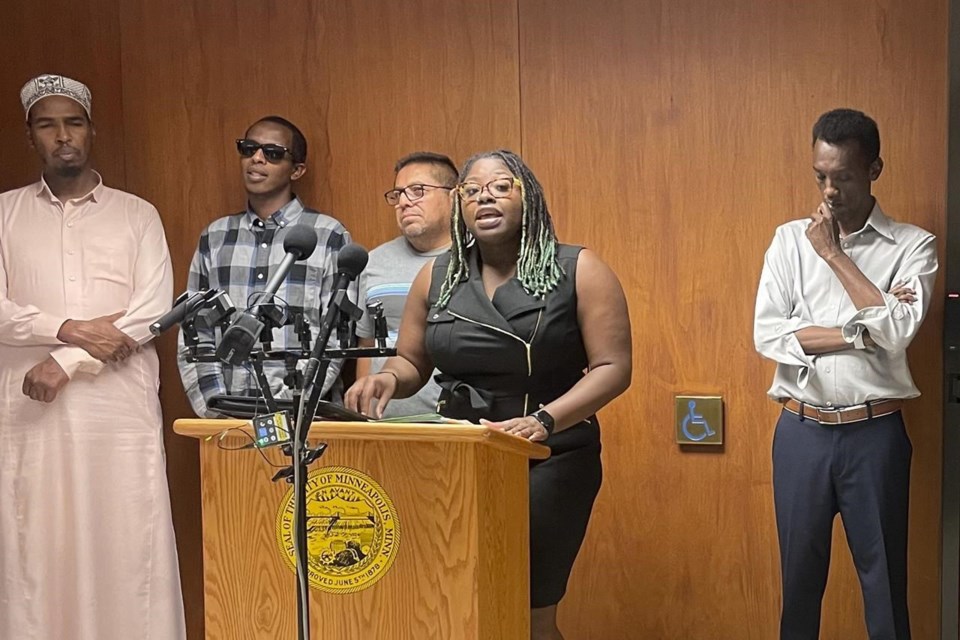MINNEAPOLIS (AP) тАФ The future of Uber and Lyft in Minneapolis has garnered concern and debate after the City Council voted last month to require that ride-hailing companies pay drivers a higher rate while they are within city limits.
Uber and Lyft responded by saying they would stop serving the Minneapolis area when the ordinance takes effect May 1, causing the city to weigh the ordinance it passed. The state could also take action, while riders and drivers are left wondering what could come next.
Here is what we know so far:
WHAT HAPPENED?
The Minneapolis City Council last month overrode a mayoral veto and that requires ride-hailing companies to pay drivers a minimum rate of $1.40 per mile and $0.51 per minute тАФ or $5 per ride, whichever is greater тАФ excluding tips, for the time spent transporting passengers in Minneapolis.
Supporters of the ordinance said the rate would ensure that companies pay drivers the equivalent of of $15.57 per hour.
Council Member Jamal Osman, who co-authored the ordinance, said in a statement: тАЬDrivers are human beings with families, and they deserve dignified minimum wages like all other workers. ... the Minneapolis City Council will not allow the East African community, or any community, to be exploited for cheap labor.тАЭ
Many East African immigrants in the Minneapolis area work as Uber and Lyft drivers and have advocated for the rate increase.
However, a recent study commissioned by the Minnesota Department of Labor and Industry found that a lower rate of $0.89 per mile and $0.49 per minute would meet the $15.57 per hour goal.
WHAT ARE UBER AND LYFT DOING?
Uber and Lyft said they can support the rate from the state's study. But if the higher rate from the Minneapolis ordinance goes into effect, the companies said they will leave the market May 1.
Josh Gold, an Uber spokesperson, said the company plans on ending its operations in Minneapolis, St. Paul and the Twin Cities metro area тАФ including the Minneapolis-Saint Paul International Airport.
The metro area includes more than 3 million people, which is more than half the state's population.
CJ Macklin, a Lyft spokesperson, said Lyft will end its operations only in Minneapolis. Lyft will still service the airport, but will not pick up or drop off passengers at any Minneapolis locations.
Both companies previously of Austin, Texas, in 2016, after the city pushed for of drivers as a rider safety measure. The companies returned after the overrode the local measure and passed a law implementing different rules statewide.
CAN THE STATE STEP IN?
Minnesota Democratic Gov. Tim Walz said he is тАЬdeeply concernedтАЭ about the possibility of Uber and Lyft leaving the Minneapolis area.
Walz said the move would have statewide impact and affect everyone who relies on the service, including people trying to get home safely from bars, people with disabilities, students and others.
State lawmakers could pass legislation that would supersede the local ordinance. But Walz said the most efficient solution is to ask the Minneapolis City Council to work out a compromise.
WHAT IS THE CITY DOING?
Minneapolis City Council members could vote to change the ordinance, take it back completely or leave it as is.
Council member Linea Palmisano said she plans to continue voting against it unless it is changed. Palmisano said she has heard from many community members who oppose it, including students, part-time and low-income workers, hospitals and more.
Palmisano said she has also heard from drivers who do not agree with it and тАЬare now at risk of losing their livelihood.тАЭ
Council member Robin Wonsley, the ordinance's lead author, said the ordinance's rate is тАЬthe right thing to do.тАЭ
тАЬFor far too long, this industry has exploited workers of color and immigrant workers for cheap labor. We have the opportunity and the responsibility to build a rideshare industry that is not based on poverty wages and exploitation," she said.
WHAT ARE PEOPLE SAYING?
Residents in the Twin Cities metro area are divided тАФ some support the ordinance because it will help marginalized workers, while others oppose it because they don't want Uber and Lyft to leave.
Marianna Brown, an Uber driver in her 60s living in a suburb of Minneapolis, supports the ordinance and isn't worried, saying other ride-hailing companies тАФ and even a local driver-owned co-op тАФ are planning to enter the Minneapolis market. Brown, a Jamaican immigrant, said drivers have been abused by Uber and Lyft for too long.
Arianna Feldman, 31, of Minneapolis, said she supports the ordinance and has taken close to 2,000 rides on Lyft because she doesnтАЩt drive, has health issues and doesnтАЩt have access to reliable public transit.
тАЬI think itтАЩs really shameful that these multimillion-dollar companies are holding us hostage like this and punishing communities for demanding a very basic right to get compensated correctly,тАЭ she said.
Jake Clark, 44, of St. Paul, is an Uber and Lyft driver and opposes the ordinance. Clark said he has never earned less than $25 per hour and has earned up to $75 per hour because he prioritizes customer service and strategizes which rides to accept.
Michael Sack, 34, of Minneapolis, also opposes the ordinance. He has cerebral palsy and serves on the Minneapolis Advisory Committee on People with Disabilities. He urged the City Council and state Legislature to find a way to increase drivers' pay while keeping ride-hailing services affordable.
тАЬIt is critical to keep the cost of rides down because people with low incomes, which most individuals with impairments have, utilize Uber and Lyft,тАЭ he said.
___
Trisha Ahmed is a corps member for the Associated Press/Report for America Statehouse News Initiative. is a nonprofit national service program that places journalists in local newsrooms to report on under-covered issues. Follow her on X, formerly Twitter:
Trisha Ahmed, The Associated Press




